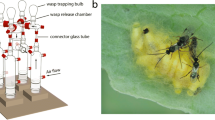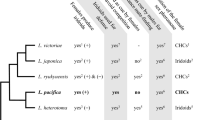Abstract
Males of the parasitoid wasp Pimpla disparis Viereck (Hymenoptera: Ichneumonidae) aggregate on parasitized gypsy moth, Lymantria dispar, host pupae when the emergence of a prospective mate is imminent or under way. We tested the hypotheses that the developing parasitoid (“DePa”) inside the host pupal case produces a pheromone that attracts and arrests mate-seeking males, and that the pheromone is most effective during the emergence of the parasitoid from the host. Results obtained in two-choice laboratory experiments, with 4–7-d-old virgin males, indicate that (1) DePa-derived semiochemicals arrest males, (2) the opening of a host pupal case strongly arrests males, and (3) the arrestment cue emanates from oral fluid secreted by both female and male parasitoids while they chew their way out of a host pupal case. This phenomenon implies that emerging females, which are haplodiploid and can reproduce without mating, do not engage in active pheromone signaling to attract males, and that mate-seeking males co-opt chemicals involved in eclosion as a mate-finding cue, taking a 50% chance that the prospective mate is a female.






Similar content being viewed by others
Notes
Aggregation pheromones are defined as substances produced by members of either or both sexes that induce members of both sexes to aggregate.
References
Alcock, J. 1978. The ecology and evolution of male reproductive behaviour in the bees and wasps. Zool. J. Linn. Soc. 64:293–326.
Ayasse, M., Paxton, R., and Tengö, J. 2001. Mating behavior and chemical communication in the order Hymenoptera. Annu. Rev. Entomol. 46:31–78.
Borden, J. H. 1985. Aggregation pheromones. pp. 257–285. in Behaviour. G. A. Kerkut (ed.). Vol. 9 in Comprehensive Insect Physiology, Biochemistry and Pharmacology. G. A. Kerkut and L. I. Gilbert (eds.). Pergammon Press, Oxford.
Collatz, J., Tolasch, T., and Steidle, J. L. M. 2009. Mate finding in the parasitic wasp Cephalonomia tarsalis (Ashmead): more than one way to a female’s heart. J. Chem. Ecol. 35:761–768.
Cremer, S., Sledge, M. F., and Heinze, J. 2002. Male ants disguised by the queen’s bouquet. Science 419:897–898.
Danci, A., Inducil, C., Schaefer, P. W., and Gries, G. 2011. Early detection of prospective mates by males of the parasitoid wasp Pimpla disparis Viereck (Hymenoptera: Ichneumonidae). Environ. Entomol. 40:405–411.
Davies, N. W. and Madden, J. L. 1985. Mandibular gland secretions of two parasitoid wasps (Hymenoptera: Ichneumonidae). J. Chem. Ecol. 11:1115–1127.
Delury, N. C., Gries, G., Gries, R., Judd, G. J. R., and Brown, J. J. 1999. Sex pheromone of Ascogaster quadridentata, a parasitoid of Cydia pomonella. J. Chem. Ecol. 25:2229–2245.
Eliyahu, D., NOJIMA, S., MORI, K., and SCHAL, C. 2009. Jail baits: how and why nymphs mimic adult females of the German cockroach, Blattella germanica. Anim. Behav. 78:1097–1105.
Field, S. A. and Keller, M. A. 1993. Alternative mating tactics and female mimicry as post-copulatory mate-guarding behaviour in the parasitic wasp Cotesia rubecula. Anim. Behav. 46:1183–1189.
Fuester, W., Taylor, P., and Eisenberg, A. 1989. Suitability of prepupae and pupae of the gypsy moth (Lepidoptera: Lymantriidae) as hosts of Coccygomimus disparis (Hymenoptera: Ichneumonidae). Ann. Entomol. Soc. Am. 18:338–341.
Fuester, W. and Taylor, P. 1993. Developmental time, oviposition behavior, and incidental mortality by Coccymomimus disparis (Hymenoptera: Ichneumonidae), a parasite of the gypsy moth (Lepidoptera: Lymantriidae). Biol. Control 3:281–287.
Godfray, H. C. J. 1994. Parasitoids: Behavioural and Evolutionary Ecology. Princeton University Press, Princeton.
Godfray, H. C. and Cook, J. M. 1997. Mating systems of insect parasitoids, pp 211–225, in J. C. Choe and B. J. Crespi (eds.). The Evolution of Mating Systems in Insects and Arachnids. Cambridge University Press, Cambridge.
Heatwole H., Davis, D. M., and WEIMER, A. M. 1962. The behaviour of Megarhyssa, a genus of parasitic hymenopterans (Ichneumonidae: Ephialtinae). Z. Tierpsychol. 19:652–664.
Herzner, G., Goettler, W., Kroiss, J., Purea, A., Webb, A., Jakob, P., Rössler, W., and Strohm, E. 2007. Males of a solitary wasp possess a postpharyngeal gland. Arthropod. Struct. Dev. 36:123–133.
Heimpel, G. E. and De Boer, J. G. 2008. Sex determination in the Hymenoptera. Annu. Rev. Entomol. 53:209–220.
Hölldobler, B. 1984. Evolution of insect communication, pp 349–377, in T. Lewis (ed.). Insect Communication. Academic Press, Orlando.
Howard, R. W. 1993. Cuticular hydrocarbons and chemical communication, pp 179–226, in D. W. Stanley-Samuelson and D. R. Nelson (eds.). Insect Lipids: Chemistry, Biochemistry and Biology. Nebraska University Press, Lincoln.
King, B. H. 2006. Mate location and the onset of sexual responsiveness in the parasitoid wasp Spalangia endius (Hymenoptera: Pteromalidae). Environ. Entomol. 35:1390–1395.
Krokos, F. D., Konstantopoulou, M. A., and Mazomenos, B. E. 2001. Alkadienes and alkenes, sex pheromone components of the almond seed wasp Eurytoma amygdali. J. Chem. Ecol. 27:2169–2181.
Leonard, D. E. 1981. Bioecology of the Gypsy Moth. pp. 9–29. in C. C. Doane and M. L. McManus (eds.). The Gypsy Moth: Research Toward Integrated Pest Management. U.S. Department of Agriculture, Washington, D. C.
Metzger, M., Fischbein, D., Auguste, A., Fauvergue, X., Bernstein, C., and Desouhant, E. 2010. Synergy in information use for mate finding: demonstration in a parasitoid wasp. Anim. Behav. 79:1307–1315.
Nichols, W. J., Jr., Cossé, A. A., Bartelt, R. J., and Bethia K. H. 2010. Methyl 6-salicylate: A female-produced pheromone component of the parasitoid wasp Spanglia endius. J. Chem. Ecol. 36:1140–1147.
Normark, B. B. 2003. The evolution of alternative genetic systems in insects. Annu. Rev. Entomol. 48:397–423.
O’neill, K. 2001. Solitary Wasps: Behavior and Natural History. Comstock, Ithaca, New York.
Peschke, K. 1987. Male aggression, female mimicry and female choice in the rove beetle, Aleochara curtula (Coleoptera, Staphylinidae). Ethology 75:265–284.
Quicke, D. 1997. Parasitic Wasps. Chapman & Hall, London, New York.
Robacker, D. C. and Hendry, L.B. 1977. Neral and geranial: components of the sex pheromone of the parasitic wasp, Isoplectis conquistor. J. Chem. Ecol. 3:563–577.
Ruther, J., Döring, M., and Steiner, S. 2011. Cuticular hydrocarbons as contact sex pheromone in the parasitoid Dibrachys cavus. Entomol. Exp. Appl. 140:59–68.
Ruther, J. and Steiner, S. 2008. Costs of female odour in males of the parasitic wasp Lariophagus distinguendus (Hymenoptera: Pteromalidae. Naturwissenschaften 95:547–552.
Ruxton, G. D. and Schaefer, H. M. 2011. Resolving current disagreements and ambiguities in the terminology of animal communication. J. Evolution. Biol. 24:2574–2585.
SAS Institute Inc. 2009. JMP User’s Guide. Version 8.0.2. SAS Institute Inc., Cary, NC.
Somjee, U., Ablard, K., Crespi, P., Schaefer, P., and Gries, G. 2011. Local mate competition in the solitary parasitoid wasp Oencyrtus kuvanae. Behav. Ecol. Sociobiol. 65:1071–1077.
Schaefer, P. W., Fuester, R. W., Chianese, R. J., Rhoads, L. D., and Tichenor, R. B. 1989. Introduction and North American establishment of Coccygomimus disparis (Hymenoptera: Ichneumonidae), a polyphagous pupal parasitoid of Lepidoptera, including gypsy moth. Environ. Entomol. 18:1117–1125.
Steiner, S. and Ruther, J. 2009. How important is sex for females of a haplodiploid species under local mate competition? Behav. Ecol. 20:570–574.
Steiner, S., Steidle, J., and Ruther, J. 2005. Female sex pheromone in immature insect males – a case of pre-emergence chemical mimicry? Behav. Ecol. Sociobiol. 58:111–120.
Steiner, S., Herrmann, N., and Ruther, J. 2006. Characterization of a female courtship pheromone in the parasitoid Nasonia vitripennis. J. Chem. Ecol. 32:1687–1702.
Syvertsen, T. C., Jackson, L. L., Blomquist, G. J., and Vinson, S. B. 1995. Alkadienes mediating courtship in the parasitoid Cardiochilis nigriceps (Hymenoptera: Braconidae). J. Chem. Ecol. 21:1972–1989.
Thornhill, R. and Alcock, J. 1983. The Evolution of Insect Mating Systems. Harvard University Press, Cambridge, MA.
Williams, G. C., 1966. Adaptation and Natural Selection. Princeton Univ. Press. Princeton.
Wilson, E. O. 1975. Sociobiology: the New Synthesis. Harvard University Press, Massachusetts.
Acknowledgements
We thank Sean McCann and Stephen Takács for photographs and for technical support and advice regarding macro photography and video setup, Stevo DeMuth for graphical illustrations, Ian Bercovitz for statistical advice, Pilar Cepeda for assistance with insect rearing, Jessika Iwanski for assistance in bioassays and in organizing the quarantine facility, and two anonymous referees for meticulous reviews and constructive comments. Funding was provided by a Natural Sciences and Engineering Research Council of Canada (NSERC) – Discovery Grant and by an NSERC – Industrial Research Chair to G. G., with Contech Enterprises, SC Johnson Canada, and Global Forest Science as sponsors.
Author information
Authors and Affiliations
Corresponding author
Electronic supplementary material
Below is the link to the electronic supplementary material.
(MP4 29085 kb)
Rights and permissions
About this article
Cite this article
Hrabar, M., Danci, A., Schaefer, P.W. et al. In the Nick of Time: Males of the Parasitoid Wasp Pimpla disparis Respond to Semiochemicals from Emerging Mates. J Chem Ecol 38, 253–261 (2012). https://doi.org/10.1007/s10886-012-0079-9
Received:
Revised:
Accepted:
Published:
Issue Date:
DOI: https://doi.org/10.1007/s10886-012-0079-9




